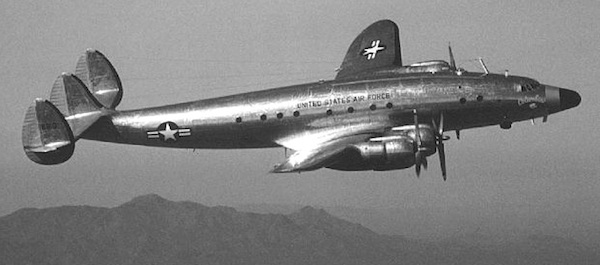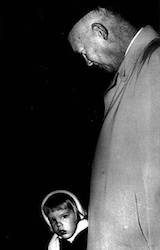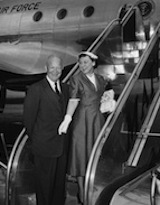
An incident involving this Lockheed Constellation VC-121 led to the use of the term “Air Force One” for any aircraft carrying the President of the United States. Dubbed Columbine II, it served as the first official aircraft used to transport Dwight Eisenhower during his presidency. It had flown him to Korea when he was president-elect. After its conversion to carry VIPs, it was redesigned VC-121A. Now, his granddaughter is one of the people trying to rescue the plane from obscurity.
On the tarmac at Marana Airport near Tucson, exposed daily to the elements, including the blistering Arizona sun, is a Lockheed Constellation VC-121. In its glory days it carried Dwight D. Eisenhower around the globe, first when he was president-elect fulfilling a campaign promise to visit Korea and then during the first year of his first term. An incident involving this aircraft gave rise the to now-common term “Air Force One” for any plane carrying the president. Eisenhower’s granddaughter, Mary Jean, is among those who have a dream for restoring this nearly forgotten piece of American history and using it to serve veterans today. On August 27, 2014, HistoryNet‘s senior editor, Gerald D. Swick, talked with her about that dream and why it comes with both a price tag and a time limit.
HISTORYNET: The term “Air Force One” for a plane carrying the president came into use during your grandfather’s administration, although aircraft had previously carried presidents Franklin Roosevelt and Harry Truman. Could you tell us the story of how the use of the term came about?
MARY JEAN EISENHOWER: This plane, Columbine II, was inspiration. It was coming in for a landing and the tower was going on call letters. Columbine II got mixed up with a commercial plane with same numbers. It was a near miss. After that, any aircraft with the president onboard was designated Air Force One, no call letters. The first plane to officially fly under the call sign Air Force One was Columbine III, but Columbine II was the inspiration.
 HN: Did you ever hear him talk about that incident or about the presidential aircraft?
HN: Did you ever hear him talk about that incident or about the presidential aircraft?
MJE: No, but I was aboard airplanes with him. I was very little, and I was mostly on Columbine III, but as soon as I saw the interior of Columbine II again the hair on the back of my neck stood up. It’s not yet fully restored, but it looked so familiar.
HN: The plane that he was in that day, a Lockheed VC-121 Constellation, was replaced the following year, although it was still used as a backup. His last flight in it was in 1959, as I recall. What happened to the plane after the Eisenhower Administration ended?
MJE: It went back into the Air Force fleet. Then, I guess somebody missed what it was, and it was put up for sale. A group of five were purchased by somebody in Arizona who intended to use them as sprayers. It was a gentleman at the Smithsonian who went looking for Columbine II—he knew Columbine III was at the National Museum of the United States Air Force at the Wright-Patterson air base near Dayton, Ohio, but it is not airworthy. He tracked down Columbine II and found it amongst this group of five.
Columbine I, by the way, was a plane granddad used in World War II. His “fleet” of airplanes were all named “Columbine” because that is the state flower of Colorado, and my grandmother, Mamie, was from Denver. In fact, they were married in her parents’ house in Denver.
HN: I’ve read that your grandfather’s Atoms for Peace speech was written while he aboard Columbine II. Can you tell us if that’s true, or is it like the myth of Abraham Lincoln writing the Gettysburg Address while on a train en route to Gettysburg?
MJE: I think it’s possible but I never heard that. Columbine III replaced Columbine II early on in his presidency; he took office in 1953, and Columbine III was put into White House service in 1954. Columbine II became the backup aircraft and often carried foreign dignitaries from New York to Washington, DC. Queen Elizabeth II was one of the last passengers on Columbine II in November of 1954, right before Columbine III entered service. I believe the Shah of Iran also rode on it, but I’d have to verify that.
Columbine II was the plane that carried my granddad to Korea when he fulfilled a campaign promise that he would go to Korea as president-elect to see what could be done about the war American troops were fighting there. It became the presidential plane after that mission. I think my favorite picture of him is the one of him eating with the troops in Korea while he was president-elect.
 HN: How were you reunited, so to speak, with Columbine II?
HN: How were you reunited, so to speak, with Columbine II?
MJE: Through John Roper, who has been working on restoring the plane to flying condition and finding a way to preserve it in a museum. He is on the board of directors of the National Airline Museum in Kansas City. I met John through a mutual friend, and John recruited me to the museum’s board, too. I was so touched by what he wanted to do with the aircraft that I also fell head over heels in love with Columbine II.
HN: What would you like to see done with this aircraft?
MJE: Our goal at the National Airline Museum is to restore it to flying condition and use it for Honor Flights for veterans. I know where the silverware and china are that were used on it, and I’m hoping to obtain those so we can use them to serve the vets. “Serving those it once led” is our tagline for the airplane; when granddad was on it, he was leading many of these veterans as they served our country. Now, we want it to serve them.
HN: What is the status on that restoration right now?
MJE: After purchasing the plane, we will need to raise funds to get it ready to fly, then get it to Kansas City and restore it onsite at the National Airline History Museum, which is based in Kansas City’s original downtown airport. We plan to have college students help with restoration of the interior. The mechanical restoration, of course, has to be led by experts, but we are inviting the public to help.
We’ve been doing personal outreach so far but would like to expand into wider outreach. We’ve only been working on this a couple of months. Our goal is to have it ready for flights by the end of 2015. Once we get it flying, we hope to have some fundraisers aboard.
HN: How extensive would the restoration be? How much of the existing plane is original to the time when it was carrying your grandfather?
 MJE: We intend to do a complete restoration. The aircraft will essentially be disassembled, cleaned, repaired and reassembled with overhauled engines and a restored interior. We want it to be exactly as it was, with a few improvements to the engine.
MJE: We intend to do a complete restoration. The aircraft will essentially be disassembled, cleaned, repaired and reassembled with overhauled engines and a restored interior. We want it to be exactly as it was, with a few improvements to the engine.
For the interior, the museum and the Air Force would have good sources for research. John’s already done a lot of that.
HN: If people want to contribute toward the purchase and restoration, whom should they contact?
MJE: We’ve preparing a website, www.columbineii.org and they can make donations there when it goes live.
What I love about Columbine II is it has so much history in its walls—its fuselage if you will. As John says, and I have to agree, it needs a voice.




